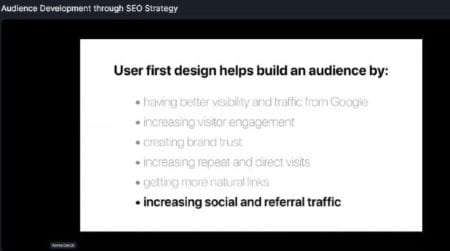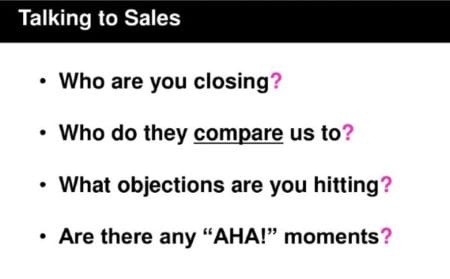Customer-Centric SEO, Design, & Branding
It started sometime during Day 1 of the Engage Conference – I noticed a theme. ‘Think like your customers.’ ‘Experience your site like your customers’. ‘Ask your customers why they bought (or why they didn’t buy) your product’.
If last year’s theme was get your data to talk to you, Engage 2020’s theme was to get your customers to talk to you.
“You’re going to hear me say ‘customer’ about 3 million times,” said Mellissa Jensen during her presentation: Moving Up the Search Maturity Curve: Becoming an SEO Native Organization. It’s really not that uncommon of a word to hear at a conference named “Engage”, but the focus and attention paid to how we relate to our customers as people rather than as datasets was really striking.

Maybe we’ve all been stuck alone inside for too long, or maybe there really is something to this “listening to our customers” thing.
How Can We Better Listen to Customers?
Our customers are talking to us all the time: through clicks, bounces, and reviews. But are we looking in the right places and are we asking the right questions?
Melissa Jensen suggests framing analytics around the customer. That means analyzing what type of language they are using and which topics are emerging. What sites are customers visiting and why?
In his presentation Audience Development through SEO Strategy, Jon Henshaw says to simply start with the golden rule. When you are thinking about user first design, make a site in the same way you would want to experience it. This helps build loyalty and engagement rather than participating in a never-ending dance of annoyance and avoidance.
For example: customers placed ad blockers because ads are annoying (bad UX), we create a workaround which creates a bad user experience so they simply leave our site. Bottom line, improve your design to improve your user experience, watch your engagement improve.
Are We Even Speaking Their Language?
Ruth Burr of UpBuild spoke to us about Natural Language Processing (NLP) and the fundamentals to making content better and easier to read. This is, at its most basic, connecting words to concepts and search intent.
Thanks to the semi-recent Google update BERT, writing with an understanding of NLP makes good content for humans better for bots too (or as I wrote down in my notes – BERT & NLP means UX = BOT LOVE). Ruth suggests not only making your content “good” for “people”, but ensuring any answers you are providing can stand alone and have salience.
For example – Q: Who is Bert’s roommate? A: In Sesame Street, Bert’s roommate is Ernie.
“Roommate” is the most salient entity in that sentence and it is also the subject. This is much better than answering the question with a mere, “Ernie”. (This answer format is especially important for those sweet, sweet Featured Snippets.)
When Data Can’t Keep Up, Ask a Real Person
As SEOs and paid search professionals rely on Google Search Console more heavily due to the rapidly changing environment, we continue to look for more resources.
Joel Klettke of Case Study Buddy says we need to find our “best-fit customers in their own words” including their pains, desired outcomes, priorities, and anxieties. But how? I don’t see that filter in any of my reports!
Joel suggests starting internally. Get marketing talking to sales to discover what kind of customers they are closing, what objections customers have, and any phrases or images that help customers understand the product or service (he calls these the “AHA!” moments). Then move to customer service. What questions are they sooooo tired of answering? What are customers consistently confused about?

After those conversations, move to external with surveys asking customers how they:
- Discovered your brand
- Evaluated you against other possibilities
- Experienced benefits and features
Then you can export and analyze the results, again looking at the language they used to describe these experiences. These can be followed-up with 3-5 in-depth customer interviews.
Lesli To of 3QDigital explained in her presentation that SERPs and user expectations change even more rapidly than technology. “79% of people who don’t like what they find on one site will go back and search for another site,” said Lesli. So, if they don’t find exactly what they are looking for immediately, they’ll go to a competitor.
Lesli says to keep up you need to optimize, test, measure, and iterate. You can’t assume that something that was working even 6 months ago is working for you today and don’t rely on SERP to tell you what isn’t working for your customers. If you focus on quality, need-based content rather than volume, you’ll be in a good place.
Speaking of content…
Optimizing for the Customer
Mellissa Jensen says, once you’ve identified your customer’s language and frequently used topics, embed that not just throughout the website, but across the organization. This creates consistency and value throughout the customer experience. If you’ve done things correctly, “SEO becomes a shepherd for ensuring content reflects the voice of the customer.”
Joel Klettke says, once you’ve conversed with your team and your customers, find places to remove friction. Remember those “AHA!” moments? The phrases and images that the sales team is using during phone calls? Those can be turned into content that, when consumed before prior to meeting with the salesperson, will deliver a higher quality lead.
Keep the Customer First and Center
It is easy to focus on how you want the customer to see your brand. It’s much harder to hear how they actually see your brand, especially if it doesn’t align with your vision. But by using the advice listed here to find the difference between customer reality and yours, you’ll be much more successful. Our customers are already telling us what they want, we just have to listen.
Kathryn is the Marketing Communications Specialist at Indow. She has been working in content marketing for over 6 years and loves that it requires continuous learning and problem solving. She attends SEMpdx events and thinks you should join her. If you start a conversation with her, lead with cat facts and it will go well.
